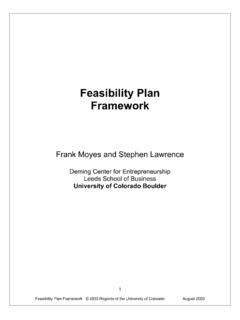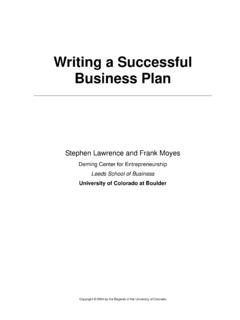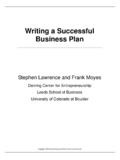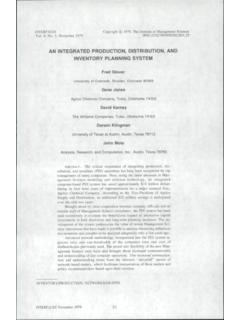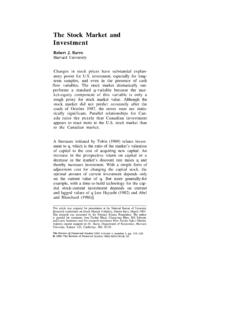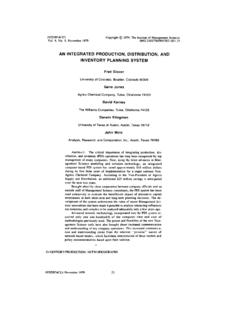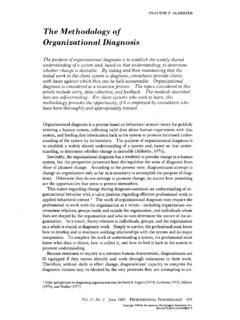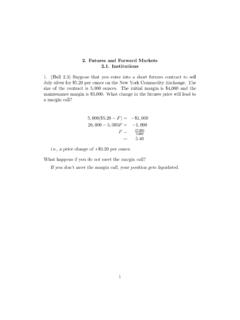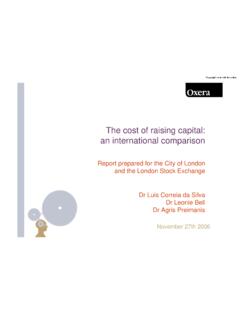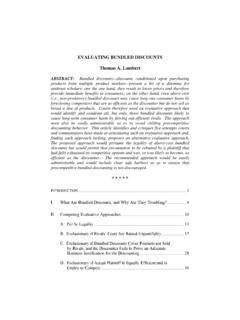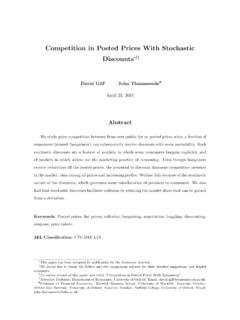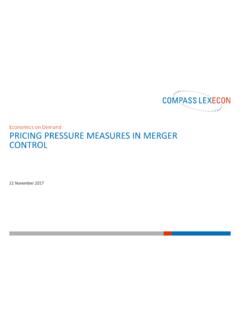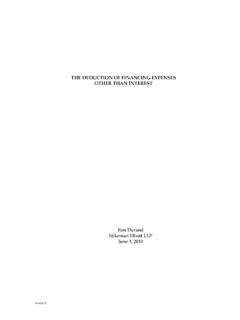Transcription of The price of corporate liquidity: Acquisition discounts ...
1 Journal of Financial Economics 83 (2007) 571 598 The price of corporate liquidity : Acquisitiondiscounts for unlisted targets$Micah S. Officer Department of Finance and Business Economics, University of Southern California, Los Angeles, CA 90089, USAR eceived 8 July 2005; received in revised form 22 December 2005; accepted 5 January 2006 Available online 27 November 2006 AbstractThis paper documents average Acquisition discounts for stand-alone private firms and subsidiariesof other firms (unlisted targets) of 15% to 30% relative to Acquisition multiples for comparablepublicly traded targets. My results are strongly consistent with the notion that sale prices for unlistedtargets are affected by both the need for, and availability of, the liquidity provided by the parents are significantly liquidity -constrained prior to the sale of a subsidiary, particularlywhen the subsidiary is being sold for cash.
2 Furthermore, Acquisition discounts are significantlygreater when debt capital is relatively more expensive to obtain, and when the parent firm has below-market stock returns in the 12 months prior to the Elsevier All rights classifications:G34 Keywords: liquidity discounts ; Marketability discounts ; Unlisted targets; Private firmsARTICLE IN $ - see front matterr2006 Elsevier All rights $A version of this paper was previously circulated under the title Acquisitions of unlisted targets: discounts , liquidity , and fire sales. I thank Andrew Ang, Jeff Coles, Ian Cooper, Harry DeAngelo, Linda DeAngelo, MaraFaccio, Jarrad Harford, Michael Hertzel, Paul Malatesta, Ed Rice, Mike Stegemoller, an anonymous referee, andseminar participants at Arizona State University, the Frontiers of Finance conference Texas Tech University, andthe University of Southern California for helpful comments and discussion.
3 Corresponding IntroductionObtaining and maintaining liquidity can be expensive for corporations and their traded firms appear to hold larger-than-expected cash balances (Opler, Pinkowitz,Stulz, and Williamson, 1999), and the owners of privately held firms pay considerable coststo access the public pools of liquidity that allow them to diversify their portfolios ( , sellshares to the public). Whether because of information disparities between firms and publicmarkets (Myers and Majluf, 1984), unexpected liquidity shortages (Opler, Pinkowitz,Stulz, and Williamson, 1999), or agency conflicts between stockholders and managers(Jensen and Meckling, 1976;Jensen, 1986), firms treat liquidity as a valuable resource. Inthis paper I investigate the cost of, and need for, accessing liquidity by selling with a need for greater liquidity , publicly traded corporations and the owners ofprivately held firms can raise cash in a variety of ways, all of which entail instance, there is considerable evidence on the cost to firms of obtaining liquiditythrough seasoned equity offerings (Smith, 1977, 1986;Loderer, Sheehan, and Kadlec,1991), sales of blocks of shares to private investors (private placements of public equity Wruck, 1989), initial public offerings (Ritter, 1987), and on how the cost and availability ofborrowing changes with firms financial conditions (Hickman, 1958;Kaplan and Urwitz,1979).
4 Considerable evidence also exists concerning control premiums paid in acquisitionsof publicly traded firms ( ,Schwert, 1996;Officer, 2003), where shareholders have arelatively reliable source of liquidity (the public market) to begin with. However, little isknown about the cost ( , the price discount ) of obtaining liquidity by selling a subsidiaryor an entire unlisted on the costs and benefits of obtaining liquidity by selling unlisted assets isimportant for at least two reasons. First, the sale of private firms and subsidiaries hasbecome an increasingly important source of liquidity and restructuring for corporations(Table 4in this paper; also seeBates, 2005), with almost two-thirds of acquisitionsreported by the Securities Data Corporation (SDC) being of unlisted targets. This impliesthat the mergers and acquisitions (M&A) market for unlisted companies is at least asimportant as the M&A market for listed companies, yet, to date, academics have little tosay about prices or premiums/ discounts in the M&A market for unlisted targets.
5 Second,acquisitions of unlisted targets, particularly subsidiaries of other firms, provide an idealexperiment in which to test fire sale (Shleifer and Vishny, 1992) and liquidity discounttheories, because the characteristics of the sellers (public firms) and the sale environment(alternate sources of liquidity ) can be measured with some precision at the time of the paper describes the level and determinants of multiples paid to acquire unlistedtargets, and how these prices vary with the financial performance of the seller and thecharacteristics of debt and equity markets around the time of the sale. I find that unlistedtargets sell at a discount of 15% to 30% on average relative to control-related trades ofpublic firms, and almost 70% of the unlisted targets in my sample are acquired at multiplesless than that offered to acquire comparable publicly traded firms. While only 12% of thesample of acquisitions of unlisted firms has enough data to compute the discount relativeARTICLE IN PRESS1 For shareholders of publicly traded firms, the liquidity problem is less severe because their shares can be tradedwith relative ease in public markets.
6 The focus of this paper is the liquidity problem for owners of assets that arenot publicly traded, and therefore costly to collateralize or Officer / Journal of Financial Economics 83 (2007) 571 598572to multiples paid to acquire comparable publicly traded firms, I show that the data appearto be sufficiently representative to provide robust and generalizable also find that publicly listed firms that sell unlisted subsidiaries exhibit characteristicsthat are consistent with liquidity constraints. Specifically, relative to other firms of similarsize in the same industry, selling firms have significantly lower cash balances, cash flow, networking capital, bond ratings, andZ-score (Altman, 1968), significantly higher leverage,and significantly negative 12-month abnormal returns leading up to the sale. While thesubsidiaries sold are small relative to the selling firms (4% of parent assets on average), theproceeds from the sale are large relative to the parent s pre-sale cash balances (105% ofexisting cash balances on average).
7 Thus, subsidiary sales appear to ease significantliquidity constraints at the selling firm. The discount for subsidiary sales from the averageacquisition multiple for comparable publicly traded firms is strongly related to the parentfirm s pre-sale stock return performance, with magnitudes suggesting economicallysubstantial effects. Parent firms sell subsidiaries, especially those in industries that areunrelated to the parent firm s principal line of business, at almost twice the discountfollowing poor return performance (when their need for liquidity is presumably greatest).The availability of alternate sources of liquidity also impacts the sale price . Specifically,sale multiples are significantly lower relative to comparable multiples for publicly tradedtargets for both stand-alone private firms and subsidiaries when corporate loan spreads(over the federal funds rate) are high.
8 This evidence is consistent with the notion thatsellers obtaining liquidity by selling nontraded assets have to accept significantly higherdiscounts when the cost of obtaining liquidity from an alternate source (borrowing) setting is clearly one in which information asymmetry between buyers and sellersalso affects sale multiples. While information asymmetry is endemic to all mergers oracquisitions, this problem is likely to be most severe in the current empirical setting, inwhich standards for information disclosure are not as high as for publicly traded firms andinformation about subsidiaries may be obscured by the parent s financial reportingchoices. While advisors for both the buyer and seller work to limit the amount ofinformation asymmetry between the parties, it seems obvious that lower sale multiples inacquisitions of nonpublic targets are at least partly caused by bidders lowering their offerprice to protect themselves against the possibility that they are less than fully informedabout the business they are acquiring.
9 Acquisition discounts for subsidiaries do appear tobe greater when my proxies indicate that there is more information asymmetry about theselling parent, but this effect is statistically and economically marginal. However,information asymmetry is a notoriously difficult construct to measure, and empiricalproxies for asymmetric information are naturally imprecise. While I find only weaksupporting empirical evidence, information asymmetry effects probably constitute a largefraction of the Acquisition discount left unexplained by the liquidity proxies used inthis acquisitionpricesfor unlisted firms is relatively straightforward, as suchprices are typically reported by either the seller (when a subsidiary is sold) or the buyer(when a privately held firm is acquired), and recorded in publicly available databases. It is,however, not so straightforward to identify the appropriate metric against which tocompare the sale price to infer the premium or discount relative to the fair value of theassets being sold.
10 I overcome this obstacle by comparing Acquisition multiples for unlistedARTICLE IN Officer / Journal of Financial Economics 83 (2007) 571 598573targets to Acquisition multiples for portfolios of comparable (industry- and size-matched)publicly traded above procedure is different from the traditional comparables method (comparingacquisition multiples for unlisted targets to average trading multiples for all comparablepublicly traded firms) that has been used and discussed extensively in the literature(Boatsman and Baskin, 1981;Alford, 1992;Berger and Ofek, 1995;Kaplan and Ruback,1995;Kim and Ritter, 1999;Gilson, Hotchkiss, and Ruback, 2000). However, weaknessesin the traditional comparables technique (Kaplan and Ruback, 1995;Kim and Ritter,1999) suggest that comparing unlisted targets to comparableacquisitions(as opposed tocomparable publicly traded, but nontargeted, firms) provides more powerful evidence onthe liquidity discount in acquisitions of unlisted targets.
